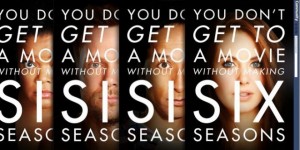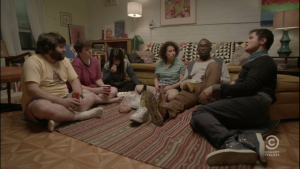Post #2 – Imagined Communities and Transmedia

Television is a cultural generator, its purpose is to entertain and spark conversation about the events depicted on screen. Narrative programs rely on an audience becoming invested in the story they are telling to ensure they come back to the show as soon as the next episode is available.
The concept of imagined communities is central to narrative television as fan appreciation helps to keep a series on the air. It gives the sense in media audiences that they exist within a large group who share a common interest for instance, an appreciation for a television show. Members of an imagined community “will never know most of their fellow members, meet them, or even hear of them” (Anderson, 1983) yet they feel that they are a part of a larger force.
Created by Dan Harmon, the sitcom Community centres on a diverse group of community college students who attended the fictional school Greendale. It first aired on NBC in 2009 and was met with critical acclaim but garnered rather low ratings for a network comedy. It cultivated a cult following and fans of the show felt as if they belonged to a community that was considered meagre yet rather zealous. In November of 2011, NBC announced it was removing Community from its schedule and this news united the fans to rally support for the show. In this day and age the increased amount of communication technologies, such as social media, has allowed niche audiences to easily find one another. The fan response to NBC’s decision is evidence of this, as the community came together to save the show. Under the hashtag #SixSeasonsAndAMovie, they ensured their voices were heard and in the process found the other members of their imagined community. In addition, Community was cancelled after season five and the fandom showed their support for the show yet again and helped it get picked up by the online streaming service Yahoo! Screen, thus allowing audiences free access worldwide.
In addition, Community was cancelled after season five and the fandom showed their support for the show yet again and helped it get picked up by the online streaming service Yahoo! Screen, thus allowing audiences free access worldwide.
Transmedia is the use of various types of media to tell a story, engage an audience and grow a brand. This strategy “allows for the opportunity to create deeper, stronger, and more varied connections between story universes and audiences” (Daryoosh Hayati, 2012). As Community continued to evolve, it began to distance itself from sitcoms by incorporating a ‘meta’ quality to its story telling, often commenting on the conventions of television and appealing to the small its small but devoted fan base. Transmedia was utilised in many ways, one of those being releasing of ninety second clips that were filmed specifically for the internet and were not from the main show.
While these were promotional material for the DVD release, they added to the reality of the world by allowing the audience to see into the lives of the characters that inhabited it. Dan Harmon’s dedication to the fans was shown through his commitment to having audio commentary for every episode on the DVD release.
The link between television shows and their audiences is vital for the longevity in this day and age as the television landscape is awash with choices, content creators must engage with their viewers in as many ways as possible to keep them coming back.
References
Anderson, Benedict (1983), “Imagined Communities”, Imagined Communities: Reflections on the Origin and Spread of Nationalism”, Vol. 2, pp. 48-59
Evans, Elizabeth Jane (2008) “Character, audience agency and transmedia drama Media” Culture & Society, Vol. 30(2), pp. 197-213
Hayati, Daryoosh (2012) “Transmedia Storytelling: A Study of the Necessity, Features and Advantages” International Journal of Information and Education Technology, Vol. 2(3), pp. 196-200
Sony Pictures DVD (YouTube Channel) (2010) “Community Season 1 – Mini Episode Study Break – “Generation Gap”, video, viewed 11 August 2015, Found at <https://www.youtube.com/watch?v=skYis9qPgVE>
Sony Pictures Television (2009) “Community”, television show

